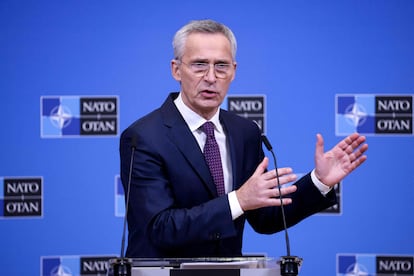NATO chief eyes bigger defense budgets, hard spending target
‘What is obvious is that if it was right to commit to spend 2% in 2014, it is even more right now because we live in a more dangerous world,’ Jens Stoltenberg told reporters

NATO Secretary-General Jens Stoltenberg on Wednesday urged the 30 member countries to commit to spending at least 2% of their gross domestic product on defense by a set date, as Russia’s war on Ukraine and other threats eat into military spending.
NATO allies agreed in 2014, after Russia annexed Ukraine’s Crimean peninsula, to halt the spending cuts they had made after the Cold War and move toward spending 2% of GDP on their defense budgets by 2024. That pledge expires next year, and NATO is working on a new target.
“What is obvious is that if it was right to commit to spend 2% in 2014, it is even more right now because we live in a more dangerous world,” Stoltenberg told reporters, after chairing a meeting of NATO defense ministers, where a first high-level discussion on the issue was held.
“There is a full-fledged war going on in Ukraine, in Europe, and then we see the persistent threat of terrorism, and we see also the challenges that China is forcing to our security. So, it is obvious that we need to spend more,” he said.
NATO allies in Europe and Canada increased defense spending for the eighth consecutive year in 2022, adding around $350 billion to their budgets. According to NATO’s most recent estimates, 10 countries are close to or above the 2% guideline. Thirteen spend around 1.5% or less.
Several member countries insist that the figure was only ever a guideline, and not a hard target.
“Instead of changing the 2%, I think we should move from regarding the 2% as a ceiling to toward the 2% of GDP as a floor and minimum,” Stoltenberg said. He added that this should not be “a long-term perspective or move towards,” but rather “an immediate commitment to spend 2% as a minimum.”
The United States spends more on its defense budget than all the other allies combined, putting 3.47% of GDP into its military coffers, according to NATO estimates for last year. Some members have suggested that NATO should move toward a 2.5% guideline. Others say that’s unrealistic.
Many countries insist that it’s the quality of the equipment and the amount of contributions that allies make to NATO operations that is most important. GDP percentages are also a slippery metric. When economies tanked during the Covid-19 pandemic, defense budgets looked bigger.
The economy of Turkey – traditionally one of NATO’s biggest defense spenders – has been ravaged by inflation and its military budget only stood at 1.22% of GDP last year, according to NATO’s estimate.
NATO leaders are expected to map out the way ahead when they meet for their next summit in the Lithuanian capital Vilnius in July.
Sign up for our weekly newsletter to get more English-language news coverage from EL PAÍS USA Edition
Tu suscripción se está usando en otro dispositivo
¿Quieres añadir otro usuario a tu suscripción?
Si continúas leyendo en este dispositivo, no se podrá leer en el otro.
FlechaTu suscripción se está usando en otro dispositivo y solo puedes acceder a EL PAÍS desde un dispositivo a la vez.
Si quieres compartir tu cuenta, cambia tu suscripción a la modalidad Premium, así podrás añadir otro usuario. Cada uno accederá con su propia cuenta de email, lo que os permitirá personalizar vuestra experiencia en EL PAÍS.
¿Tienes una suscripción de empresa? Accede aquí para contratar más cuentas.
En el caso de no saber quién está usando tu cuenta, te recomendamos cambiar tu contraseña aquí.
Si decides continuar compartiendo tu cuenta, este mensaje se mostrará en tu dispositivo y en el de la otra persona que está usando tu cuenta de forma indefinida, afectando a tu experiencia de lectura. Puedes consultar aquí los términos y condiciones de la suscripción digital.
More information
Archived In
Últimas noticias
Most viewed
- Reinhard Genzel, Nobel laureate in physics: ‘One-minute videos will never give you the truth’
- Oona Chaplin: ‘I told James Cameron that I was living in a treehouse and starting a permaculture project with a friend’
- Pablo Escobar’s hippos: A serious environmental problem, 40 years on
- Charles Dubouloz, mountaineering star, retires at 36 with a farewell tour inspired by Walter Bonatti
- Why we lost the habit of sleeping in two segments and how that changed our sense of time










































